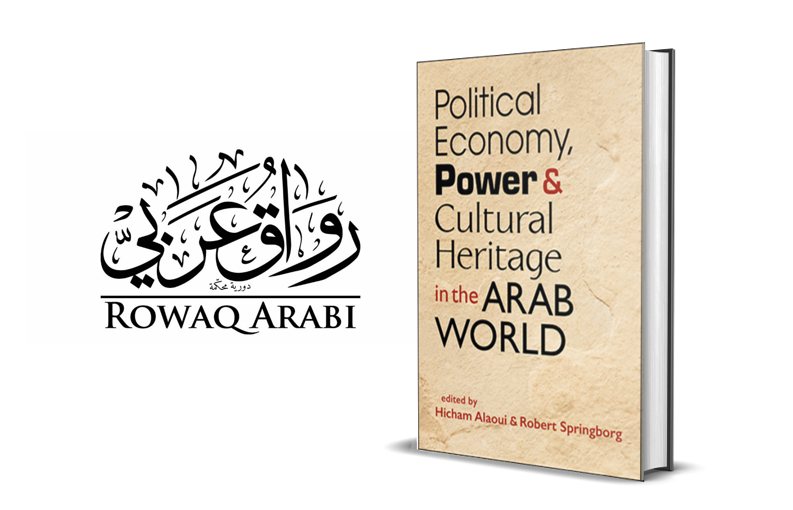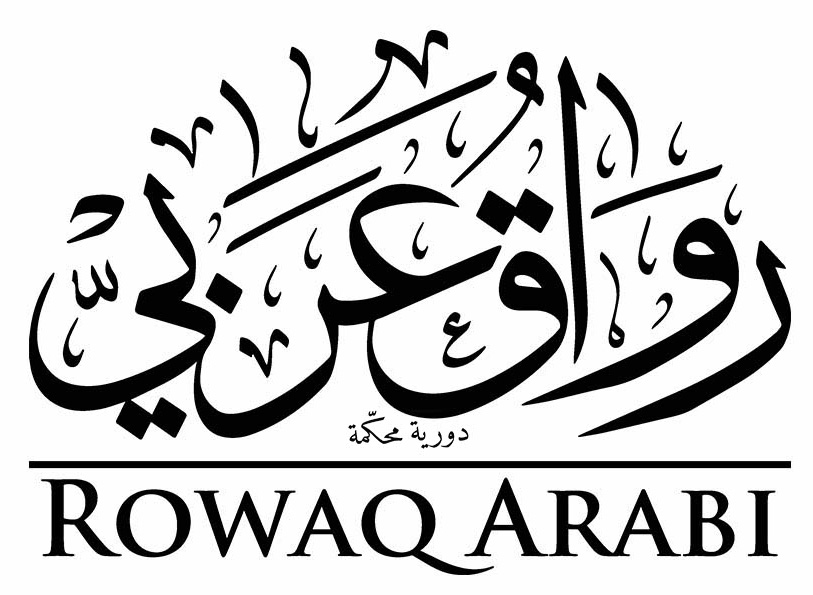Book Review: ‘Political Economy, Power, and Cultural Heritage in the Arab World’ by Hicham Alaoui and Robert Springborg

Citation: Aldardari, Sima. 2025. “Book Review: ‘Political Economy, Power, and Cultural Heritage in the Arab World’ by Hicham Alaoui and Robert Springborg.” Rowaq Arabi 30 (2): 31-34. https://doi.org/10.53833/SQQQ5666.
Title: Political Economy, Power, and Cultural Heritage in the Arab World
Editors: Hicham Alaoui and Robert Springborg
Publisher: Lynne Rienner Publishers
Year of Publication: 2025
E-Book ISBN: 9798896160052
Political economy dynamics in Arab states since Western imperialism have often been marked by oppression and monopolisation. While these dynamics have been widely studied, the role of heritage within them has received little attention. The book Political Economy, Power, and Cultural Heritage in the Arab World offers valuable multidisciplinary insights that explore different forms of heritage; material heritage, such as artefacts and monuments, and immaterial heritage, such as language – and how power shapes their use by state and non-state actors for political legitimacy, national identity building, and financial gain. This is why the book argues that the political economy of heritage deserves closer examination to understand how power instrumentalises it. It does so by linking current state and non-state dynamics in the Arab region to colonial legacies that continue to influence the perception and management of heritage today.
The book consists of twelve chapters, beginning and ending with contributions from its editors, Hicham Alaoui and Robert Springborg. The main case studies cover countries across the region, including Saudi Arabia, Egypt, Jordan, Lebanon, Libya, and Tunisia, along with regional chapters such as those on media production, which also discuss Syria. The volume also includes a chapter on China, offering a comparison between authoritarian states in the Arab region and another form of authoritarian control over heritage that is less centralised. Additionally, a chapter on Italy presents a more democratic model of decentralisation, which the editors advocate as an approach to heritage that involves local communities, benefits them, and reflects their histories and identities even when these diverge from the state’s conception of heritage.
The book divides the Arab region into two main categories of countries: those that are relatively homogeneous, ruled by authoritarian regimes that use cultural heritage to reinforce their legitimacy; and those that are more heterogeneous, with weaker states where local actors, such as militias, reproduce their own competing versions of cultural heritage in the absence of a strong state capable of assuming that role.[1] Both types, nonetheless, use cultural heritage production for economic gain as well as for internal and external legitimation in varying degrees.
In Saudi Arabia, for instance, the state has embarked on Vision 2030 to diversify its economy and build a new national identity, with cultural heritage production ‘dominated by a tight circle of state power centred on the king and the crown prince’.[2] Heritage is also used for ‘external regime legitimation, including global image-making’.[3] This is evident in Saudi Arabia’s ‘reliance on foreign consultants at the expense of local consultation’, which has resulted in some ‘domestic disconnect’ from the Vision.[4] Jordan, on the other hand, is not an oil-rich country and therefore has long depended on international actors, mainly the US, to develop its tourism sector and determine what is valuable to foreign visitors. Here, colonial logics continue, as heritage sites deemed valuable often ‘link up with a legacy of American heritage work in the region, particularly with biblical archaeology’,[5] promoting ‘an imaginary historical map of Jordan…while actively bypassing other histories’.[6]
International influence in the region is therefore not a modern phenomenon, but a continuation of colonial legacies; inclusive of ‘considerations of what kind of heritage marked great civilisations’.[7] This is reflected in the imperialist focus on monumental sites such as ‘the Pyramids of Giza, Petra, or Palmyra’, which colonial powers once ‘co-opted as their own’.[8] Post-independence states have colluded in sustaining these colonial legacies, as seen in Egypt’s emphasis on its Pharaonic past as the defining element of national heritage. Similar dynamics are evident in Lebanon, notably through the Phoenician/Christian versus Arab/Muslim divide, which was ‘reinforced during the Mandate period’ to serve France’s political interests.[9] This legacy has influenced not only social and sectarian relations but, as Lina Tahhan shows in Chapter seven, also national identity and museum representations. This has been further exacerbated by the weakness of the Lebanese state and the ‘lack of an official truth and reconciliation commission’ following the civil war.[10]
In Chapter nine, the examination of language as both heritage and capital, particularly among Tamazight groups in Libya and Tunisia, also ‘speaks to the continuation, institutionally, of colonialism’.[11] In Tunisia, the French colonial education system left a lasting impact on politics and culture, unlike in Libya, where no comparable colonial legacy persisted.[12] Moreover, the book shows that just as colonial powers once used heritage for their own interests, postcolonial states have continued this practice, often relying on similar tools of control and exclusion. As Ethan notes in Chapter eight, this has created a ‘trauma loop’ in Libya – and, by extension, across the region – a cycle beginning with Italian colonisation and continuing through Qaddafi’s rule and the civil war.[13]
Ultimately, the book argues that heritage is not neutral; it is produced through power and can be shaped or manipulated by those who control it. It also holds the capacity to generate economic value, confer both local and international legitimacy, and construct national identity. At its core, therefore, the book is about power: who decides what heritage is valuable, who determines how that value is monetised, and for whose benefit. Each chapter reinforces this argument by situating heritage within its historical and political-economic contexts, showing how its meaning and value shift with each regime and/or political change. The book also calls for balance: strong state institutions are needed to safeguard heritage for the public good, yet policies must be decentralised to ensure inclusivity and local participation. What remains absent across much of the region are spaces where people can question and challenge state narratives of heritage, spaces that would reflect the region’s linguistic and cultural diversity. As the editors contend, these varied histories should not be seen as contradictory, but rather coexist in harmony to ensure sustainability and peace.
What the book overlooks, however, is the impact of ongoing colonialism on heritage in the region, particularly in Palestine, where settler-colonial political-economic dynamics appropriate and erase local Palestinian heritage. This omission is significant, as the same colonial power structures discussed throughout the book remain deeply present but largely unaddressed in this context. Nevertheless, the volume remains a timely and important contribution to understanding how power, colonial legacies, and political economy intersect in the preservation and presentation of heritage across the Arab region, often amplifying or erasing aspects of heritage to serve political and economic ends. This mismanagement of the region’s ‘rich cultural heritage’, the editors write, ultimately squanders ‘its potential political and economic value, while failing to adequately preserve much of it’.[14]
AI Assistance Statement
An AI tool was used only for proofreading the English version of the book review.
This article is originally written in Arabic for Rowaq Arabi.
[2] Karen Exell, “Saudi Arabia: Appropriation and Accommodation Under a Futurist Umbrella,” in Political Economy, Power, and Cultural Heritage in the Arab World, ed. Hicham Alaoui and Robert Springborg (Lynne Rienner Publishers, 2025), 27.
[3] Ibid.
[4] Ibid., 36.
[5] Charlotte Vekemans, “Jordan: Pursuing Legitimacy and Economic Growth Through Heritage Development,” in Political Economy, Power, and Cultural Heritage in the Arab World, ed. Hicham Alaoui and Robert Springborg (Lynne Rienner Publishers, 2025), 58.
[6] Ibid., 64.
[7] Ibid., 66.
[8] Ibid., 49.
[9] Lina G. Tahan, “Lebanese Museums: Selective Representations of Heritage,” in Political Economy, Power, and Cultural Heritage in the Arab World, ed. Hicham Alaoui and Robert Springborg (Lynne Rienner Publishers, 2025), 128.
[10] Ibid., 133.
[11] Lindsay J. Benstead, “Libya and Tunisia: The Political Economy of Language Use,” in Political Economy, Power, and Cultural Heritage in the Arab World, ed. Hicham Alaoui and Robert Springborg (Lynne Rienner Publishers, 2025), 164.
[12] Ibid., 173.
[13] Ethan D. Chorin, “Libya: Fractured Heritage, Fractured State,” in Political Economy, Power, and Cultural Heritage in the Arab World, ed. Hicham Alaoui and Robert Springborg (Lynne Rienner Publishers, 2025), 145.
[14] Alaoui and Springborg, “Toward a Political Economy of Cultural Heritage in the Arab World,” 21.
Read this post in: العربية

